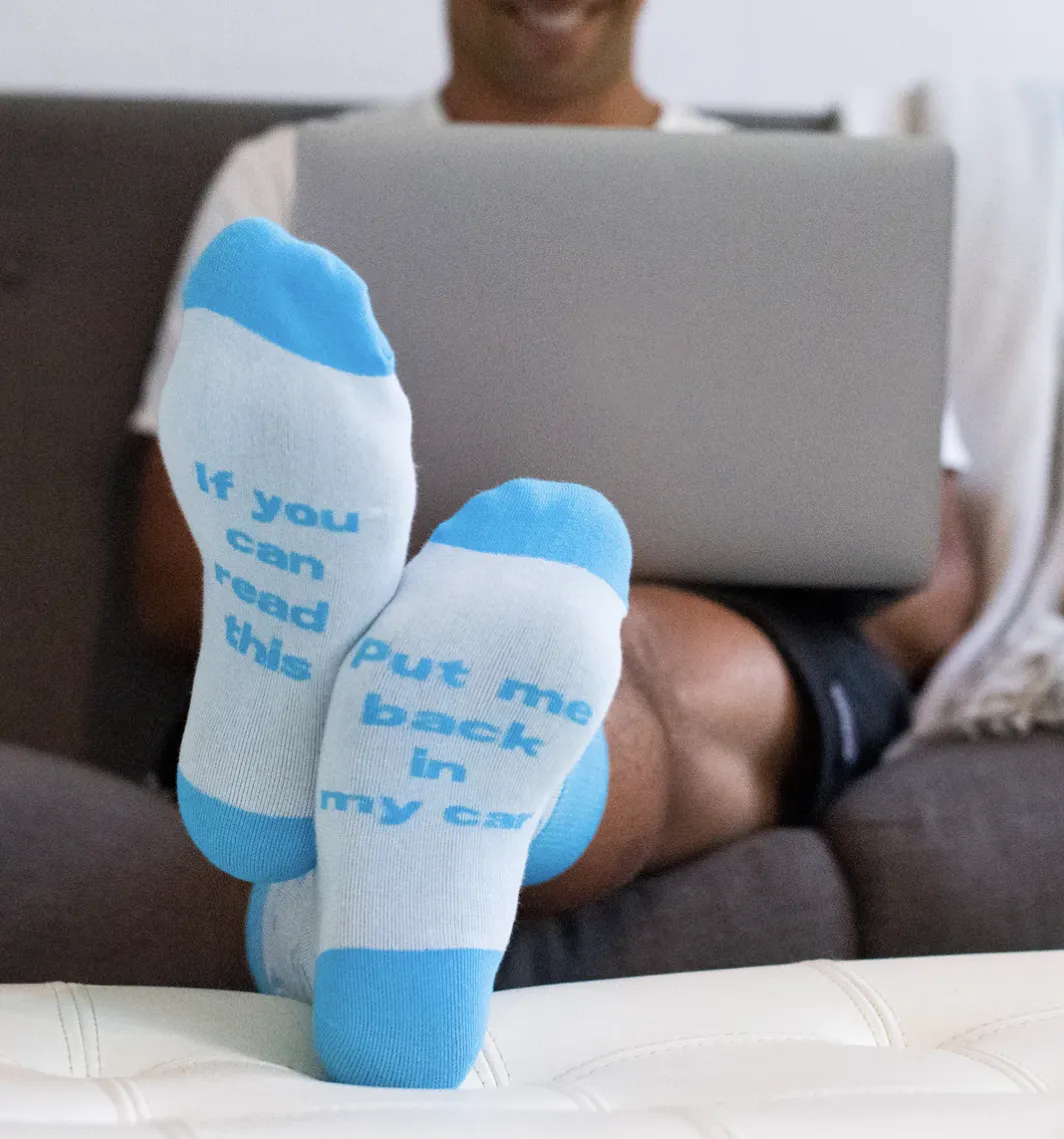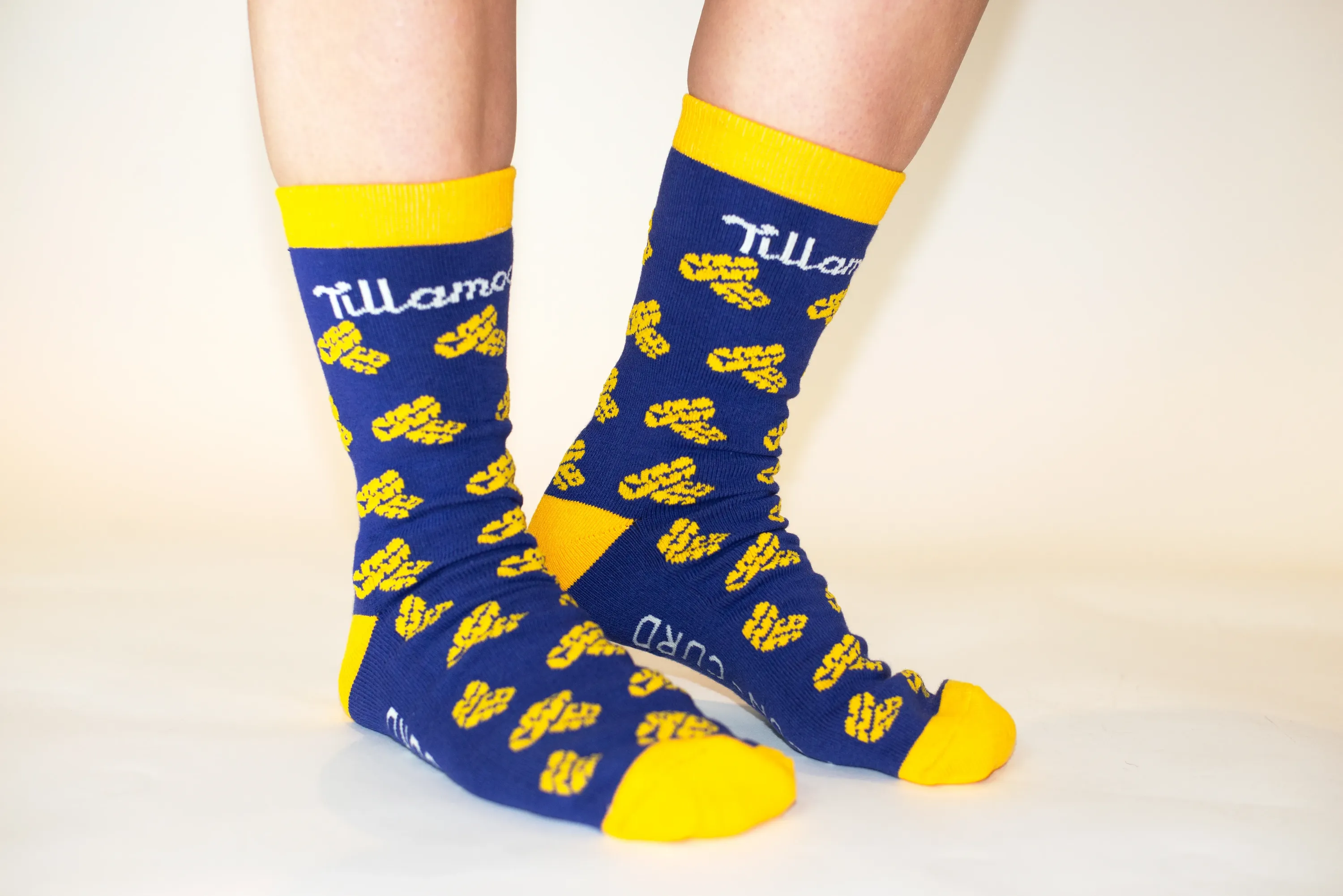How to wash socks (the right way)
- Home
- Custom apparel
- Socks
- How to wash socks (the right way)

Your socks don’t look as good as they used to. Maybe they’ve just reached the end of their life. But could they have lasted longer? A few simple changes to your laundry routine can preserve the color and fit of your favorite pair of socks for many wears to come.
Discover these proven ways to wash your socks and maintain their original quality.
Key Takeaways from “How To Wash Socks Properly”
Step 1: Sort socks by material and color
Separate socks into distinct piles before washing to protect their quality and color. Put black socks and dark colors in one group, white socks in another, and light colors in a third. Match pairs as you sort to identify missing socks before washing.
Sort your socks by material before washing them to protect their quality. Put dress socks, silk, wool, and cashmere socks in a separate pile for gentle washing since these delicate fabrics need special care to maintain their softness and shape.
A few minutes of sorting will protect your socks from pilling, fading, and lint accumulation. Your dress socks and custom-designed pairs will stay smooth and professional through more wash cycles.

Step 2: Turn socks inside out
Bad odors and stains collect inside your socks where they contact your feet. Turn each sock inside out before putting it into the washing machine so the most soiled parts of the sock get the most agitation and soap contact.
Inside-out washing also protects designs or patterns on your socks. The agitation of the wash cycle can fade and wear down sock exteriors over time. When socks face inward, the outer designs stay crisp and colors remain bright.
Step 3: Use cold water
Hot water degrades elasticity and accelerates fading. Use cold water to keep socks in shape and preserve colors. Cold water removes dirt and sweat while protecting sock fibers.
Set your washing machine to cold (60 – 65°F) for regular washing. Athletic socks and heavily stained items can handle a warm setting when needed but never use high-temperature settings.
Pro tip: For very dirty socks, soak them in cold water for 30 minutes before washing. This loosens dirt without damaging the fabric.
Step 4: Add a gentle laundry detergent
A mild detergent (gentle detergent without harsh chemicals or bleach) cleans but doesn’t damage sock fibers, stretch elastic bands, and dull colors. For tough spots, apply a stain remover before washing.
Use half the recommended amount of detergent since extra soap leaves a residue that attracts dirt.
Step 5: Choose the right washer settings
Select cold or warm water since hot water can damage fibers and fade colors. Set your washer on a delicate or gentle cycle with slower spin speeds. Your socks will still get cleaned but the gentle agitation will minimize wear.
For the most protection, place socks in a mesh laundry bag to prevent losing pairs and reduce friction from other clothes. Skip fabric softeners and bleach since they break down elastic and fade colors.
Step 6: Air dry flat or hang
The harsh heat from dryers quickly breaks down sock fibers and causes colors to fade. Instead, use air drying to preserve your socks’ shape, stretch, and vibrant colors. For best results, lay your socks flat on a drying rack since this method prevents unwanted creases and keeps the material from stretching out of shape.
If you don’t have a flat drying rack available, you can hang your socks from a towel bar, shower rod, or clothesline, though these alternatives may leave slight pinch marks where the socks are clipped or folded. Regardless of your drying method, always keep socks out of direct sunlight to prevent accelerated color fading.
If you decide to use the dryer, tumble dry without heat.
Special care instructions
Different sock materials and styles require specific washing techniques. Follow these guidelines for these delicate materials to maintain their qualities and extend their wear life.
How to wash white socks
White socks require specific washing steps to maintain their brightness without damaging the fabric. Here’s what to do:
- Keep white socks separate from colored clothes because dye from other items will stain white socks.
- Soak dirty white socks in warm water and pre-treat with laundry soap before washing them. This removes tougher stains from heels and toes.
- Put white socks in the washer with other white items.
- Pick the delicate cycle for dress socks to prevent damage; athletic socks are fine on regular cycles.
- Pour 1⁄2 cup of vinegar (or baking soda) into the rinse cycle to remove soap residue that makes socks look dingy.
- Air dry socks flat on a drying rack to keep their shape.
How to wash wool socks
Wool socks, especially Merino wool, need gentle cleaning. Here’s what to do:
- Fill a sink with cool water and add wool-specific soap; regular detergent will damage wool fibers.
- Soak wool socks for 10 minutes in the soapy water. Don’t rub or twist the fabric because this causes felting and shrinkage.
- Rinse the socks in cool water until all the soap is gone. Hot water will shrink wool socks.
- Roll each sock in a clean white towel to remove excess water. Never wring wool socks.
- Reshape your wool socks while they’re damp. Smooth out the toe and heel areas.
- Air-dry wool socks flat on a towel away from direct sun or heat. Never put wool in the dryer.
How to wash compression socks
Compression socks need a proper care routine to maintain their pressure levels and elastic support. Here’s what to do:
- Turn compression socks inside out before washing. This cleans the part that touches your skin and protects the outer fibers.
- Fill a sink with lukewarm water and mild soap. Hot water will damage the compression materials.
- Soak the socks for 5 minutes. Don’t scrub or twist because this will stretch out the compression bands.
- Rinse in cool water until no soap remains. Extra soap residue will irritate your skin.
- Press the water out with a clean towel. Don’t wring or squeeze the socks.
- Lay compression socks flat to dry. Never use the dryer because heat ruins the pressure levels.
The best way to store socks
Your sock drawer needs proper organization to protect your favorite socks. Here’s what to do:
- Fold each sock with its match. Don’t stretch the cuff by rolling or balling socks together.
- Stack socks flat in your sock drawer by type. Athletic socks, dress socks, and wool socks should stay separate.
- Place heavier socks at the bottom of the drawer. Light dress socks go on top to prevent crushing.
- Keep the sock drawer organized in sections. Activewear in one area and work socks in another to make your morning selection simple.
- Store seasonal socks in breathable cloth bags when not in use. Plastic containers trap moisture and lead to mildew.
- Remove worn-out socks from your sock drawer.
How to wash socks FAQs
- Is it better to wash socks by hand or machine?
- Machine washing works well for most casual socks and athletic wear. Hand washing is best for delicate fabrics such as silk, cashmere, and wool. Always check the label for specific washing instructions.
- What is the best way to wash dark dress socks?
- Dark dress socks need special attention to prevent fading. Wash them inside out in cold water with similar colors. Use a light detergent and skip fabric softeners, which leave a residue that dulls dark colors.
- Where should I keep my dirty socks before washing them?
- Store dirty socks in a mesh laundry basket that allows airflow. Don’t let wet socks sit at the bottom of a closed hamper; doing so would cause mildew. Sort socks by color as you add them to the basket to simplify washing day. Sort them into matching pairs before washing to avoid ending up with mismatched socks after laundry.
- Should I use stain remover on my dirty socks?
- Apply stain remover to tough spots on light-colored socks before washing. For dark socks, spot-test stain removers first since harsh cleaners can fade the dye. Make sure to always use natural stain removers.
- Do I need to add fabric softener when washing socks?
- You should not use fabric softener when washing socks, as this can leave a waxy coating on them. Eventually, this build-up of wax will wear down your socks and lock in bad odors as the fabric will be unable to absorb water or detergent.
